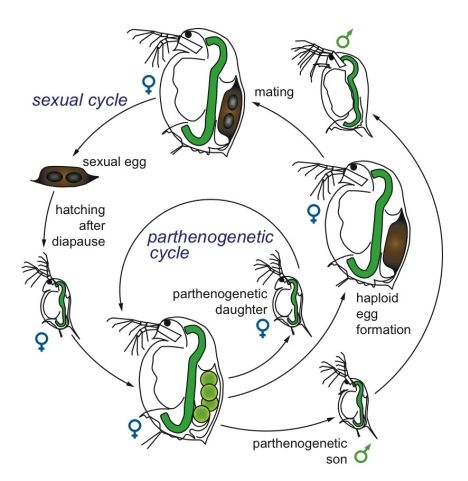Reproduction
The reproduction cycle of the D. pulex consists of alternating asexual and sexual phases. They reproduce asexually when the population is in need of rapid growth and conditions are favorable. The method used for their asexual reproduction is parthenogenesis. Parthenogenesis is when an unfertilized egg develops into an individual.

In the first step of this process, Daphnia first molt to increase their size. After each molt, approximately 2-20 eggs are put into the brood chamber. Once the eggs are developed into immature females, the mother Daphnia enters the next molting stage and the juvenile Daphnia are released. The new organism can then feed and begin to mature at a very, very rapid rate.
Sexual reproduction takes place when conditions for parthenogenesis become less favorable. Less favorable conditions can include lack of food availability or poor temperatures. With sexual reproduction eggs produced by the females can hatch into males. Male Daphnia then internally fertilize the eggs of female Daphnia, and the fertilized eggs are kept in the brood chamber of the female. During the next molting stage of the female, the cavity which holds the winter eggs (called the ephippium) releases its eggs. These are resting eggs which allow for persistence from one season to the next. The eggs can last through harsh winters and can resist freezing. Sexual reproduction allows for more genetic variation across the Daphnia population which increases likelihood for more survival throughout. Click here for a really cool video demonstrating Daphnia reproduction!
Above is a picture of Daphnia male sperm.
Daphnia usually have a life-span of about 10-30 days; however, if the environment is in good condition and free of predators, that can change to almost 100 days!
Find out about interactions with other organisms.
Go back home.
